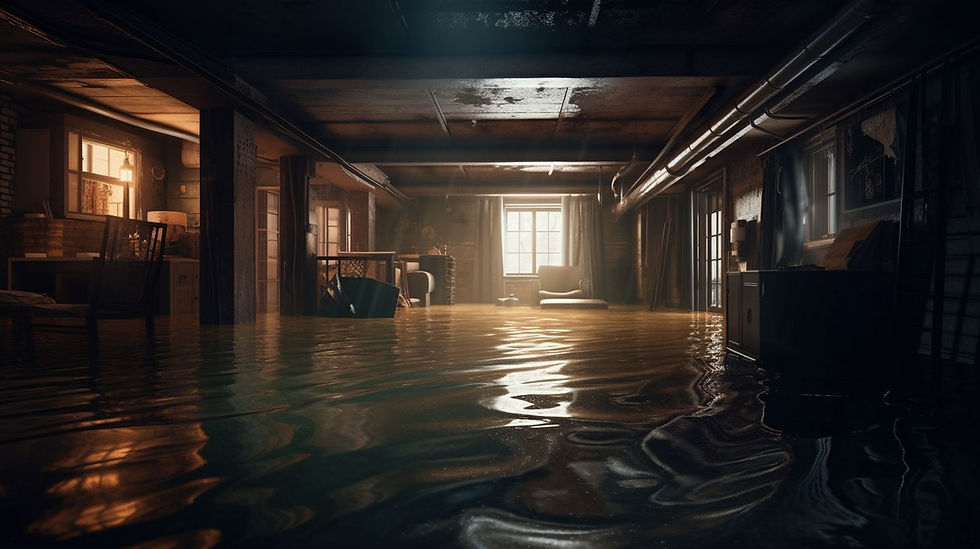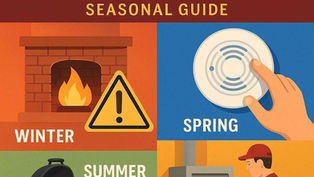How to Protect Your Home from Spring Thaw Flooding in Manitoba
- Relief Restorations
- Aug 30
- 5 min read

How to Protect Your Home from Spring Thaw Flooding in Manitoba
Every spring in Manitoba, homeowners brace themselves for the same challenge: melting snow, rising water, and the threat of flooding. The shift from winter’s deep freeze to warmer temperatures can be quick, and when snow and ice melt rapidly, our soil and drainage systems often can’t keep up. The result is spring thaw flooding, a yearly problem that damages basements, weakens foundations, and leads to expensive restoration work if not prevented.
If you live in Winnipeg or anywhere across Manitoba, preparing your home for spring runoff is more than a good idea; it’s essential. In this guide, we’ll cover why flooding happens during the thaw, how to spot risks in your home, and the steps you can take to keep water out before it becomes a major issue.
Why Spring Thaw Causes Flooding in Manitoba
Manitoba’s geography makes it especially prone to flooding during the thaw. Here’s why:
Frozen ground can’t absorb water. When snow and ice begin to melt, the ground underneath is often still frozen solid. Instead of soaking in, water runs along the surface, pooling around homes and seeping into basements.
Rivers and ice jams. Manitoba is home to large rivers like the Red and the Assiniboine. During spring, ice chunks can jam up the flow, forcing water to back up and spill over banks. This flooding risk isn’t just rural, it affects Winnipeg neighbourhoods as well.
Heavy snowpack. Some winters leave us with above-average snowfall. A quick warm-up or rain on top of snow accelerates melting, overwhelming drainage systems.
Poor neighbourhood drainage. Older areas of Winnipeg often have flat grading and outdated stormwater systems, making localized flooding common.
The combination of these factors means every homeowner should take flood prevention seriously.
Signs Your Home Is at Risk
Not every house will flood during the thaw, but certain red flags mean you’re at higher risk:
Cracks in basement walls or foundation that allow water entry.
Negative grading, where soil or landscaping slopes toward your house instead of away.
A sump pump that hasn’t been tested, or worse, no sump pump at all.
Blocked or damaged eavestroughs and downspouts.
A history of basement dampness or musty odours (early warning of moisture problems).
If you notice any of these signs, you’ll want to take preventative action before spring runoff begins.
Prevention Tips to Protect Your Home
Inspect & Maintain Your Sump Pump
Your sump pump is your first line of defense against basement flooding. Test it before the thaw by pouring water into the pit and ensuring it activates properly. Consider installing a battery backup system; flooding often coincides with power outages, and without backup, your pump won’t protect you.
Check Grading & Drainage
Water should naturally flow away from your home. If the ground around your foundation slopes inward, add soil to create a gentle slope outward. Downspouts should extend at least six feet away to prevent pooling near walls. Simple changes to grading and drainage can significantly reduce risk.
Clear Snow and Ice Away from Foundation
As snow begins to melt, move it at least 1–2 meters away from your foundation. Snow piled right against the house directs water inward. On roofs, watch for ice dams, which occur when melting snow refreezes at the roof’s edge. Ice dams force water back under shingles, leading to leaks and interior water damage.
Seal Foundation Cracks and Windows
Small foundation cracks or gaps around windows are gateways for spring meltwater. Use waterproof sealants to patch visible cracks before the thaw begins. Install window well covers to prevent water pooling around basement windows, which is a common point of entry during floods.
Maintain Gutters & Eavestroughs
Clogged eavestroughs trap meltwater, causing it to spill over and pool around your home. Clean them thoroughly before spring and check for leaks or misaligned sections. Gutter guards are a worthwhile investment for long-term maintenance.
What to Do if Flooding Happens
Even with the best preparation, sometimes flooding still occurs. If water enters your home:
Prioritize safety. Shut off power in affected areas to avoid electrical hazards.
Move belongings. Relocate valuables, furniture, and electronics to dry areas immediately.
Remove water quickly. The longer water sits, the greater the damage and the higher the chance of mould growth.
Call professionals. Emergency water damage restoration in Winnipeg ensures proper drying, disinfection, and protection against long-term issues.
Fast action is critical, mould can start forming within 24–48 hours in damp environments.
How Relief Restorations Can Help
At Relief Restorations, we specialize in protecting homes from the lasting effects of flooding. Our services include:
24/7 Emergency Water Damage Restoration – Fast response when you need it most.
Moisture Surveys & Inspections – Identify hidden water damage that may not be visible.
Mould Remediation – Prevent mould from spreading after a flood.
Basement Waterproofing & Prevention Solutions – Long-term strategies for flood protection.
By working with a local Winnipeg restoration team, you gain peace of mind knowing your home is protected during Manitoba’s unpredictable spring thaw.
Conclusion
Spring thaw flooding is a reality every Manitoba homeowner must prepare for. With proactive steps, like maintaining your sump pump, improving grading, sealing cracks, and clearing snow, you can drastically reduce your risk. But if flooding does occur, quick professional help is essential to limit damage and prevent mould.
At Relief Restorations, we’re committed to helping Winnipeg homeowners protect their properties and recover quickly from water damage. Book a moisture survey or flood prevention inspection today, and safeguard your home before the thaw arrives.
Contact Relief Restorations Today
Schedule a mould air test, moisture survey, asbestos testing, remediation, inspection, or consultation with our team to ensure your home is protected. Let us help you safeguard your home and restore peace of mind, knowing that you’re in good hands.
Our Testing, Inspection, & Remediation Services Include:
Water Damage – Restoration | Content Restoration | Moisture Surveys
Mould – Remediation | Air Testing | Fogging | Inspections
Asbestos – Remediation | Testing | Inventories | Inspections
Non-Structural Demolition Services
Ceiling Stipple Removal
Vermiculite Removal
Attic Blow-in Insulation Installation
We Want to Hear From You!
Have you ever had spring flooding? Share your experience in the comment section below; your insights could help others.
If you found this post helpful, don't forget to like & share it with your friends and family to spread the word.
Stay Informed - Subscribe
Subscribe to our blog and newsletter at the top or bottom of this page for tips, information, exclusive offers, and more expert advice on property maintenance, mould prevention, and other restoration, remediation, and health tips to keep your home or property safe and healthy.
About Relief Restorations
At Relief Restorations, we specialize in providing comprehensive mould remediation, water damage restoration, asbestos removal, light demolition, inspection and testing services across Winnipeg and Manitoba, Canada.
With a focus on safety and quality, our expert team is dedicated to restoring your property and ensuring a healthier living environment. Whether you're a homeowner, business, tenant, landlord, or property manager, you can trust us to handle any restoration or remediation challenge with professionalism and care.
Contact us today to learn more about how we can help protect your property.
Please note: The information on this post and website are for entertainment and educational purposes only and does not replace professional inspection or remediation services or offer legal or medical advice.



















Comments